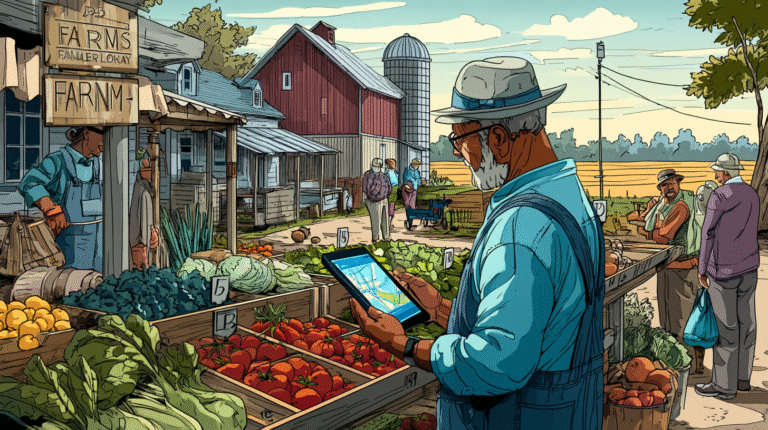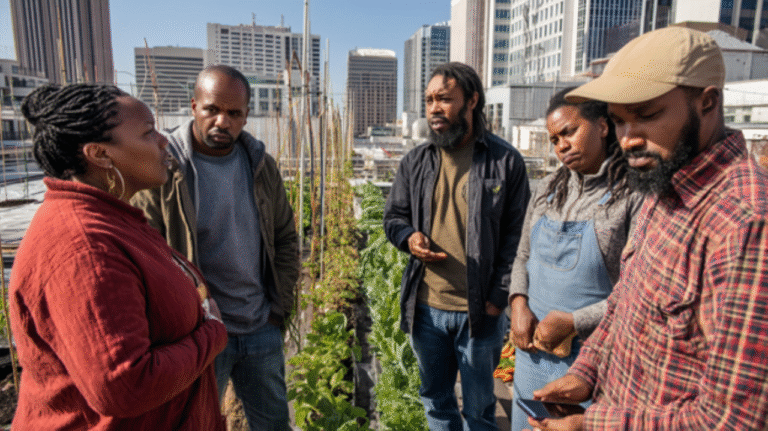The Ultimate Guide to Local SEO for Small-Scale Farms
Local SEO transforms your small farm from hidden gem to community hotspot.
You need to claim your Google Business Profile, enhance with accurate details, and maintain fresh content about your seasonal produce.
Don’t forget quality photos and customer reviews—they’re your digital curb appeal!
Even tiny farms can outrank bigger operations by showcasing unique specialties and authentic stories.
Spend just 15 minutes weekly updating your profile and tracking results. These digital seeds yield real-world harvests when planted correctly.
Key Takeaways
- Claim and verify your Google Business Profile, adding complete information, quality photos, and keyword-rich descriptions.
- Post regular updates on seasonal produce, farm activities, and special events with location-based keywords.
- Optimize your website with local keywords, mobile-friendly design, and fast-loading pages for improved visibility.
- Actively manage customer reviews by responding to feedback and encouraging satisfied customers to leave ratings.
- Differentiate from larger competitors by highlighting unique farm attributes, specialties, and authentic local stories.
Want to Learn How to Rank #1 in Your Town?
Get my free checklist: “The 5 Quick Fixes to Get Found on Google Maps.”
Why Local SEO is Non-Negotiable for Modern Farms

The era has passed when farmers could rely solely on roadside stands and word-of-mouth.
Today’s customers pull out their phones and search “farms near me” before ever hitting the road.
Without local SEO, your farm is essentially invisible to these digital-first shoppers.
Think about it: when was the last time you drove around aimlessly looking for something?
Your local visibility as a farm directly impacts:
- Who finds you online (hint: your neighbors with money to spend)
- Whether you appear in Google Maps results
- If customers trust you before visiting
The good news? You don’t need to be a tech wizard to win at local SEO.
Even simple steps like claiming your Google Business Profile can dramatically increase who sees your farm online.
With over 55% of web traffic now coming from mobile devices, optimizing your farm’s online presence for mobile users is absolutely essential.
Local SEO helps develop customer relationships through direct communication on digital platforms, strengthening your farm’s community presence.
Your customers are searching. Will they find you?
How Google Maps Has Replaced Word-of-Mouth
While farmers have relied on neighborhood chatter and community connections for generations, Google Maps has fundamentally transformed how customers find local businesses—including your farm.
Your Google Maps farm listing now serves as your digital storefront. When someone types “fresh produce near me,” will they see your farm?
| Traditional Word-of-Mouth | Google Maps Reality |
| Limited to existing contacts | Reaches thousands of potential customers |
| Information spreads slowly | Instant visibility to searchers |
| Details often get distorted | Accurate hours, location, and offerings |
Think about it: when was the last time you asked for directions instead of pulling out your phone?
Your customers are doing the same thing—searching Google Maps first, not asking their neighbor where to buy fresh eggs.
Remember that your farm’s visibility in Maps results is heavily influenced by proximity to searchers, which means localizing your marketing efforts to nearby communities is essential.
According to research, 46% of searches on Google demonstrate local intent, making your farm’s presence on Google Maps critical for connecting with potential customers in your area.
Step-by-Step: Claiming and Optimizing Your Google Business Profile

Farmers overwhelmed by technology, I see you! Setting up your Google profile doesn’t have to be complicated.
Start by searching for your farm on Google Maps – you might already have a profile waiting to be claimed.
The simple process works like this:
- Visit the Google Business Profile website
- Claim your existing listing or create a new one
- Verify ownership (usually through a postcard sent to your address)
- Fill in EVERYTHING – name, address, phone, hours, website
- Add your farm’s special attributes (organic, U-pick, etc.)
Use your regular farm business Google/Gmail account when setting up to ensure consistent account management.
For most farms, you’ll need to wait for a physical postcard with a verification code as this is the primary verification method Google uses to confirm legitimate businesses.
Once verified, enhance by:
- Uploading quality photos of your produce and farm
- Creating a keyword-rich description
- Adding all your products and services
- Selecting the most accurate business categories
This single step makes you visible to local customers!
What to Post (and When) to Stay Relevant
Now that your Google Business Profile is up and running, it’s time to keep it fresh with content that grabs local attention!
Think of your GBP as your farm’s digital roadside stand. You wouldn’t let your actual stand get dusty, right?
Mix up your content with:
- Fresh product photos with mouthwatering descriptions
- Seasonal updates about what’s growing now
- Behind-the-scenes peeks at farm life
- Simple recipes using your produce
- News about local restaurant partnerships
Post consistently around your farming schedule—more frequently before farmers’ markets or harvest seasons. Tuesday and Thursday mornings often get solid engagement.
Remember to include your location in posts: “Just harvested these strawberries in [Your Town]!”
Using location-based keywords will significantly improve your visibility in local search results, helping nearby customers find your farm more easily.
Responding quickly to customer reviews demonstrates your commitment to service and can help convert 46% of local searches into actual sales for your farm.
A well-maintained Google Business Profile keeps you visible when locals search for fresh food!
How to Beat Bigger Competitors in Local Search

David versus Goliath scenarios happen every day in local search—and small farms can absolutely win! Your size can actually be your advantage in local farm marketing when you utilize the right strategies. Studies show that organic search drives 51% of visitors to business websites, making SEO essential for small-scale farms. Implementing geofencing strategies can help attract customers within your farm’s immediate vicinity.
| Strategy | How It Works | Why It Works |
| Niche Specialization | Focus on unique products your big competitors don’t offer | Creates searchable specialty terms |
| Community Stories | Share authentic local connections and stories | Builds trust Google recognizes |
| Review Management | Actively gather and respond to customer reviews | Enhances your local |
credibility fast
Remember that big farms often miss the personal touch. Your farm’s unique story and commitment to sustainability can attract dedicated local customers while those massive operations stay generic.
Want to stand out? Highlight what makes your farm special in every post. LFG
Tracking Results Without Hiring an Agency
While big farms might hire expensive agencies to handle their SEO, small-scale farmers can absolutely track their own marketing results with simple, free tools.
Google Analytics is your farm SEO secret weapon. It shows who’s visiting your site and how they found you—no tech degree required!
Google Analytics reveals your invisible website visitors, showing exactly how people discover your farm—without needing fancy tech skills.
Look at these easy ways to monitor your progress:
- Check how many people visit after searching “farms near me”
- Track which pages visitors spend the most time on
- Monitor which products get the most attention online
Set up a simple spreadsheet to record monthly views and local search rankings. This takes just 15 minutes weekly but delivers game-changing insights.
Your farm’s online presence deserves attention just like your crops. You’ve got this!
Common Mistakes That Keep Farms Invisible

Even the most beautiful, productive farm can remain completely hidden from local customers if certain digital marketing mistakes aren’t addressed.
Want to get discovered on Google? Avoid these common pitfalls:
- Incomplete Google Business Profiles missing basic info like hours, photos, or accurate categories
- Inconsistent contact details across different websites and directories
- Missing local keywords like “organic tomatoes near [your town]” on your website
- Mobile-unfriendly pages that frustrate smartphone users
- Ignoring reviews from customers (the good AND the not-so-good)
The digital equivalent of putting up road signs to your farm stand, these elements tell Google who you’re and where to send hungry customers.
Regular technical SEO audits can identify hidden issues preventing your farm’s website from ranking well in local search results.
Ensure your farm’s website loads quickly on all devices by compressing images and minimizing heavy scripts for better mobile experience.
Don’t worry—fixing these issues isn’t rocket science! LFG
Quick Start Checklist: Your First 30 Days to Better Rankings
Four weeks is all you need to transform your farm’s online visibility from invisible to unmissable.
Let’s create your roadmap to local SEO success!
Week 1: Claim and verify your Google Business Profile—this is Google for farms 101, folks!
Week 2: Choose accurate business categories and upload 5-10 high-quality photos of your farm and products.
Week 3: Collect at least three 5-star reviews from loyal customers.
(Don’t be shy—people love helping small farms!)
Week 4: Create your first three Google Posts highlighting seasonal products or upcoming market dates.
Between harvests or while waiting for seedlings?
Update your contact info and business hours on all platforms to guarantee consistency.
Remember that implementing schema markup will help search engines better understand your farm business and improve your local search visibility.
Adding well-researched local keywords to your website can significantly improve your ranking as local searches lead to purchases 28% of the time.
Your farm deserves to be found!
Related Questions
How Do I Handle Seasonal Changes in My Farm’s Google Business Profile?
Update your Google Business Profile seasonally by changing categories, adjusting hours, posting about available produce, and refreshing photos. You’ll stay relevant in local searches and keep customers informed about what’s currently available at your farm.
Can I Optimize for Specific Farm Products I’m Known For?
Yes, you can enhance your signature products! Add them as services in Google Business Profile, employ product-specific keywords, post seasonal updates, and encourage customers to mention specific products in their reviews.
Should I Create Separate Profiles for Farm Stands and U-Pick Operations?
Yes, you should create separate Google Business Profiles if your farm stand and U-pick operations have different locations or truly distinct services. This improves local search visibility while better targeting specific customer intentions.
How Do Negative Reviews Impact My Farm’s Local Search Rankings?
Negative reviews mainly hurt your rankings through reduced quality scores and customer sentiment metrics. You can minimize damage by responding professionally, encouraging new reviews, and addressing service issues that led to criticism.
What Local SEO Strategies Work Specifically for Rural Farming Areas?
In rural farming areas, focus on locally-relevant keywords, claim your Google Business Profile, join agricultural directories, create content about regional farming issues, and encourage reviews from nearby customers. Don’t forget consistent NAP across all platforms.
What it all boils down to
You’ve got everything you need to put your farm on the digital map!
Start with your Google Business Profile today, post those gorgeous harvest photos regularly, and watch as local foodies find their way to your farm stand.
Local SEO isn’t just for tech companies—it’s for anyone who wants customers to find their business. Your incredible produce deserves to be unearthed.
Your best harvest season is just one optimization away!





